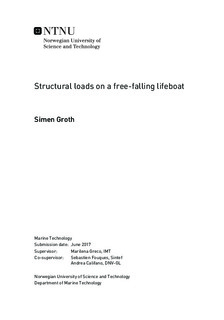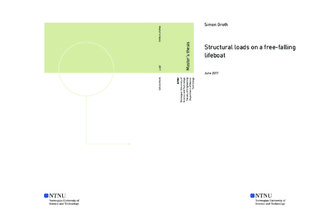| dc.description.abstract | Free-falling lifeboats are a method of escaping hazardous events in open sea. They rest at a skid until released and launched into the water. It is important that the use of free-falling lifeboats ensure a safe evacuation. In this master thesis, a simplified free-falling lifeboat geometry has been used to investigate the physical phenomena connected with this evacuation method.
The hydrodynamic results are obtained with a computational fluid dynamics (CFD) program, Star-CCM+, and the structural results from a finite element method (FEM) program, Abaqus. There has been conducted a sensitivity and convergence study of the CFD simulations, and a convergence check for the FEM model.
The lifeboat has been solved with seven different parameters under the assumption that the air is incompressible, where the main initial conditions were a water entry angle of 60 degrees, a velocity of 20,61 m/s and with centre of gravity -0.5 m in zbody-direction from the body centreline. These initial conditions have been changed with ± 5 degrees for the water entry angle, ± 5 m/s for the body fixed velocity and ± 0.2 m for the centre of gravity. For the structural assessment only the initial conditions have been used, but with four load cases. One load case where only inputs to Abaqus from Star-CCM+ for the aft is established (one-way coupling) with air modelled as incompressible. Two load cases where inputs are given to both of the programs (two-way coupling) for the hull and aft, with air as incompressible. The fourth load case is the same as the first load case, but with air modelled as compressible.
Results from the initial conditions shows that the lifeboat experiences the same physical phenomena as a real lifeboat. It experiences an air cavity closure on the aft and it follows the preferred trajectory suggested by DNV-GL. For the parameter investigation, it was shown that the change in water entry velocity gave the largest difference on most of the results, with respect to the initial conditions. This includes a variation of the air cavity closure time and peak magnitude, and water exit time. The change in water entry angle gave the largest change in maximum submersion compared with the initial conditions. The difference in maximum submersion created also a larger pressure on the aft, due to the hydrostatic pressure. The change in COGz did not create much differences on the results.
When using a one-way coupling simulation, with air modelled as incompressible, the structural results were unrealistic. Where all the different shell thicknesses exceeded yield and ultimate strength. It was found that hydroelastic effects matter for this load case. With the two-way coupling, for the aft, the results were almost the same. Due to a coarser mesh discretization in the CFD simulations with the two-way coupling, the results from one-way and two-way coupling are not comparable. When the air was modelled as compressible the response from the aft with a shell thickness of 20 mm was found to be quasi-static. With this thickness, the aft was also able to withstand the stresses from the air cavity closure and the air bubbles oscillations.
When using the hull in the two-way coupling it was seen that the splash crown had the largest influence on the stresses on the lifeboat. Here the 20 mm, 10 mm and 5 mm shell thickness were able to withstand these stresses without going into the plastic zone, while a shell thickness of 2.5 mm exceeded the Tresca yield criterion. It was also found that the solution obtained was of a quasi-static approach. | |

